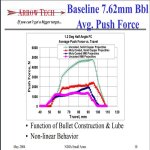I am conducting a little test on the force required to seat a jacketed bullet from sitting in the throat to be pushed 3/4's of an inch into the rifling.
I am using a piece of new barrel and a 300 grain .338 bullet.

This test was following what I had to do to remove a bullet that was driven by a primer only - fully into the rifling on a .300 Savage. Extremely hard to drive out with a flat ended steel rod.
In this test the bullet pushed into the rifling about half way and then the back of the bullet started to deform... at 180 pounds on the press.
It took 150 pounds to push the bullet out.
I can only speculate the primer drove the bullet as far as it did because of the pressure and the momentum behind the moving bullet...
I am using a piece of new barrel and a 300 grain .338 bullet.

This test was following what I had to do to remove a bullet that was driven by a primer only - fully into the rifling on a .300 Savage. Extremely hard to drive out with a flat ended steel rod.
In this test the bullet pushed into the rifling about half way and then the back of the bullet started to deform... at 180 pounds on the press.
It took 150 pounds to push the bullet out.
I can only speculate the primer drove the bullet as far as it did because of the pressure and the momentum behind the moving bullet...









































































